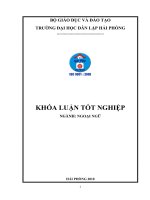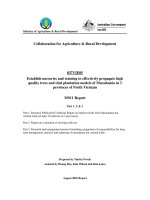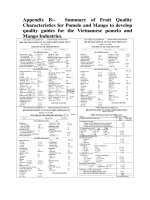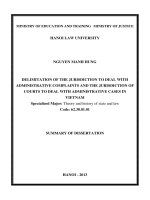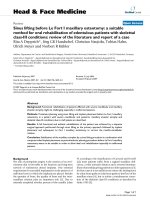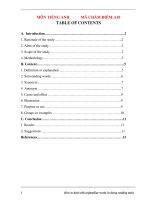Suitable policies for compensation and benefits to deal with high turnover in pouyuen vietnam enterprise, ltd
Bạn đang xem bản rút gọn của tài liệu. Xem và tải ngay bản đầy đủ của tài liệu tại đây (27.12 MB, 73 trang )
HO CHI MINH CITY UNIVERSITY OF FOREIGN LANGUAGES INFORMATION TECHNOLOGY
•
SCHOOL OF FOREIGN LANGUAGES
~JJ1(6
SUITABLE POLICIES FOR COMPENSATION AND
BENEFITS TO DEAL WITH HIGH TURNOVER IN
POUYUEN VIETNAM ENTERPRISE, LTD.
..
. '
: Mr. NGO QUOC DUY, M.A.
: NGUYEN THI PHUONG THAO
Student
: HAOI03
Class
Student No. : 0171204
Advisor
HCMC, July 2005
ADVISOR'S COMMENT
~.
•
I
•
.
EXAMINER'S COMMENT
EXAMINER'S COMMENT
•
ACKNOWLEGDEMENTS
.•
Thanks all the lecturm; in the School of Foreign Languages
at Ho Chi Minh
University of Foreign Languages - Information Technology for giving me an
available opportunity to write the graduation paper, their sound advice and
support. Especially to Mr. Vu Quoc Anh, who motivate and lend me many
valuable books.
I would like to present my deep gratitude to Mr. Ngo Quoc Duy, my advisor
for giving me a chance to study and gain much knowledge and experience,
and his valuable guidance during the process of making this paper.
I would like to express my deep thanks to all those people whose enthusiastic
help has been invaluable in the preparation
Thi Kieu Loan, HR Administrator
of this study paper. Ms. Huynh
of Bristol-Myer
Squipp Representative
Office in HCMC; Mr. Tran Duc Long and Mr. Ly Ba Thuan, Assistants HR
Manager of Pou Yeun Vietnam Enterprise, Ltd. all were extremely helpful
by providing practical advices and related data.
My sincere thankfulness
is also addressed to all the authors whose books,
websites and graduation paper give a great support for the study.
I am especially indebted to my parents and all my friends who always much
love, care, encourage, and give me a hand.
Nguyen Thi Phuong Thao
ABSTRACT
This paper contributes to help both employer and employee solving their
problems with high turnover. In fact, employees leave their companies due to
they do not satisfy with human resource management
(HRM) policies.
Compensation and benefits are the one of primary significant factors in
motivating and developing the employee satisfaction as well as expanding
the firm in a lowest cost. Therefore, the purpose of this study is to determine
how to plan reasonably financial policies.
/
If enterprisers consider this matter clearly, they will not only retain desirable
staff but also manage their labor cost effectively. The research covers all the
compensation
policies
in
theory,
thereafter,
analyzes
the
strengths,
weaknesses, opportunities, and threats in practice depending the company's
human resource strategies. Recognition of reasons for high pace of turnover,
the author would like to suggest some improvements that should be carried
out both by the government and the businesses' efforts. /
The paper focuses on how to put forward suitable compensation and benefits
plans in Pou Yuen Vietnam Enterprise Limited so that it could have the
employees'
loyalty. Moreover, unemployment rate of Vietnam will also be
reduced considerably. Hence, I expect that Personnel Managers will have
different view about the importance of work force in their success as well as
the government pay more attention to planning projects to support both local
andf",eign en'e,!,ri,e" to givethemthe mo,' favo;ableCOOditiO/~
CONTENTS
ACKNOWLEDGEMENT
ABSTRACT
CONTENTS
Page
INTRODUCTION
1
CHAPTER 1:
AN OVERVIEW OF HUMAN RESOURCE MANAGEMENT AND
COMPENASTION AND BENEFITS
1,1. Overview
and definition
of human resource
management
5
I.1.1. Overview of human resource in Vietnam
5
1.1.2. Definition of Human Resource Management (HRM)
6
'.
,
7
1.2. Compensation
1.2.1. Definition of compensation
7
1.2.2. Complying with Legal requirements
9
1.2.3. Determining Internal Fairness
11
1,2.4. Determining External Fairness
12
1.3. Benefits
13
1.3.1. Legally required benefits
14
1.3.2. Voluntary benefits
15
21
1.4. Conclusion
CHAPTER TWO: POU YUEN VIETNAM ENTERPRISE, LTD.
AND SWOT ANALYSIS
2.1. Introduction
of the company
22
2.1.1. Introduction of inside supporting factories of PYV
23
2.1.2. An overview of DS 1 factory
28
31
2.2. SWOT analysis
2.2.1. Strengths
31
2.2.2. Weaknesses
35
2.2.3. Opportunities
39
2.2.4. Threats
40
CHAPTER 3:
SUGGESTIONS
TO HCMC PEOPLE'S
COMMITTEE,
GOVERNMENT
POLICIES IN ORDER TO CREATE POUYUEN'S IMAGE AND IMPROVE
STAFF'S COMMITMENT
3.1. To HCMC People's
Committee
42
3.1.1. HCMC - Overview
42
3.1.2. EPZs and IPs in HCMC
44
3.1.3. Suggestions
45
3.2. To the Government
48
3.2.1. Review of measure of narrowing the gap between domestic and
foreign investment,
and legal issues for improving
the labor's rights
48
3.2.2. Minimum salary should be higher
50
3.2.3. Invest in human resource development programs
52
CONCLUSION
APPENDIX
54
c,uitable policies for compensation and benefilto
deBl with hiph turnover in Dou Yuen Vietnam
INTRODUCTION
Unemployment may be considered as a national problem for any countries,
specially, developing ones. For instance, Vietnam has great internal strengths such
as: wealthy natural resources, favorable geographical positions, plentiful labor
force, etc. but it still can not handle the high statistic of unemployment. According
to a joint survey conducted by the Ministry of Labor, War Invalids and Social
Affairs and the General Statistic Office, Vietnam's unemployment rate is 5.78%
by July, 2003. In addition, our country has a population of 42,1 million people of
working age, or 61.22% of the total population as a result the number of
unemployment is 2,433,380. /
Indeed, unemployed workers are consisted of new graduated students, unqualified
workers, competent
workers and even skillful or excellent
ones. Most of
employees, however, want to get a stable job but there are many influences make
them change their occupations. The reasons might be one of the facts that they are
not satisfied with their companies about the job status, working environment, their
direct supervisors or managers. Among them, there are millions of employees
simply drop out their previous career as they can not stand the unfitting
compensation.
/
In practice, every instance organizations have tried to more clearly identify and
then focus on factors that impact their success. One factor that seems to be
receiving more attention than any other is those who work for organizations. The
organizations whether they are small or large have experienced that they can not
lack effective human resource investment in spite of numerous endowments. In
short, the creative and faithful employee is the competitive advantage and may
even be the single most significant impact on the company's performance.
-1-
8uitable policies for compensation and benefit to deal with hiqh turnover in Dou Yuen Vietnam
"Human resources, the key to success"
(Konosuke, 1977)
Nevertheless, there are more and more employers who always have to face with
the high pace of turnover in staff. It means that the rate at which workers leave the
company and are replaced is too high. The matter maybe they do not recognize
and pay much attention to set sound policies that meet their workers' needs and
wants. The first consideration is how satisfied employees are with their work. The
more satisfied they are with their current jobs the less likely they are to change
jobs. These enterprises
are really confused to solve this problem because
replacing good employees by freshmen is a big loss. Likewise, recruitment and
training freshmen are an extremely wasted time and money while the budget
could be saved much by retaining current workers who want to quit. Therefore, it
will be more profitable to retain them by planning appropriate schemes than to
search the new ones.
To recognize the importance of the human resource department in the business's
success, the author would like to evaluate at the policies in dealing with high
turnover in Pou Chen Group's two branches in Dong Nai province and Ho Chi
Minh City. The total number of workers in this organization in Vietnam is about
64,000 but it has permanently to cope with medium 10% of turnover rate. The
author would narrow down the study in DS1 factory in Ho Chi Minh branch, with
10,270 workers and hundred of leavings and replacements monthly. The main
cause is that the current wage policies are not enough to compensate employees
but various benefits in Pou Yuen Vietnam. Could we imagine how essential and
urgent it is to improve the human resource's policies to get more satisfied and
proper developed employees?
-'2-
6uilable policies for compensation and benefit to deal with hi8h turnover in Dou Yuen Vielnam
In the past, many managers and experts found that human resource is one of the
most complicated departments to manage. Nowadays, most enterprisers have
more difficulties in this area when they have to succeed both internal and external
•
companies. The human resource policies have to satisfy not only the workers but
also the organizations'
needs. This paper aims at finding some suitable
compensation and benefit policies in order to maintain and attract high quality
labor forces.
A suitable policy is needed to fit with the company's external factors such as:
economic situation, competition, the Government rules and regulations and so
forth. Furthermore, every person has his or her different job satisfactions, different
needs, and different choices. As a result, if we just automatically apply the
compensation plans for Pou Yuen Vietnam Enterprise Limited, we certainly could
not retain our employees. The fact that firms differ in their business and human
resource strategies suggests that the most effective compensation strategy may
differ from one firm to another. Thus, individuals entering
environment
require an awareness
the business
of the importance of human resources.
Businessmen have started to recognize that their success depends much on the
ability to attract, retain and develop potential employees.
This secondary study is established by the selected knowledge mainly from books,
articles, information from the Internet. The author combines and analyzes not only
the information
from the above sources but also interviewing
Personnel
Executives in a few enterprises and blue-collar workers in Pou Chen's branch in
Ho Chi Minh City. Moreover, the author has gained much more useful ideas from
university lectures, which enable her to complete the study successfully and
persuasively.
-3-
c,uitBble policies for compensBUon Bnd benefit to deB! with hi8h turnover in Dou Yuen VietnBm
The research concludes three chapters with the following contents:
Chapter I: The paper starts with the Overview of Human resource management
and focuses on the area of Compensation and Benefits.
Chapter 2: Introducing the scale and organizational structure of Pou Yuen Vietnam
Enterprise Limited. Then the research goes on with SWOT analysis (Strengths,
Weaknesses, Opportunities, and Threats).
Chapter 3: Some suggestions to Ho Chi Minh City People's Committee and the
Government Policies in order to create the company's culture and, particularly, to
improve the staffs commitment.
-4-
CHAPTER ONE
AN OVERVIEW OF HUMAN RESOURCE MANAGEMENT
AND COMPENSATION AND BENEFITS
8uitable policies for compensation and benefit to deal with high turnover in Dou Yuen Vietnam
CHAPTER ONE
.>
AN OVERVIEW OF HUMAN RESOURCE
COMPENSATION AND BENEFITS
1.1.
MANAGEMENT
AND
Overview and definition of human resources management
1.1.1. Overview of human resource (HR) in Vietnam
Historically, people used to be familiar with Personnel Management which simply
contains five functions: recruitment,
selection, training, payment, and legal
compliance. The Personnel Managers did not combine the organization goals and
their staffs' job satisfactions; they just want to find someone whenever vacancies
need to be replaced and as a result the employees got nothing but their money
from work or some training courses.
/
The Vietnam General Confederation of Labor (VGCL) is the Communist Party
labor organization. This is the highest organization under which all local trade
unions must operate. The VGCL represents 95% of unionized public sector
workers, 90% workers in state-owned
employees.
companies, and 50% private sector
/
One of Vietnam's primary assets is a relatively well-educated and inexpensive
labor force. The Vietnamese have a reputation as a hardworking and industrious
people, and Vietnamese cultural traditions emphasize learning and a respect for
authority. The country's history has made the Vietnamese
people open to
foreigners, and easy to communicate with despite of language barriers.
/
We could realize that a shortage of skilled labor exists in Vietnam lately due to an
antiquated educational
system. In order to promote the skills necessary
to
encourage foreign investment, the government has initiated a project to increase
literacy rates from 91% of population to 95%. Another reason for this project is
- 5-
/
ouitable policies for compensation and benefit to dCElIwith hiBhturnover in Dou Yuen Vietnam
that foreign investment has led to some positive changes in the nature of the labor
force. For example, foreign investment has enabled local staff to access advanced
technology and learn the dynamics of Western management methods.
The shortage of qualified skilled labor in Vietnam has led to job-hopping and
employee poaching, especially among the more highly skilled workers. To avoid
this, employers must show employees that they are respected and trusted. Hence,
all the businesses need to have different strategies to develop their human
resources to join the global trade because:
"A company is known by the people it keeps."
In the beginning of 1990s, many international companies tend to apply the concept
Human Resource Management (HRM) instead of Personnel Management due to
its broad and strategic vision.
1.1.2. Definition of Human Resource Management
(HRM)
"HRM is the recognition of the importance of an organization's workforce as vital
human resources contributing to the goals of the organization, and the utilization of
several functions and activities to ensure that they are used effectively and fairly for
the benefit of the individual, the organization, and society. "(Schuler. et aI, 2000).
/
HRM activities aim to reward, develop, motivate and maintain the staffs so they
should be interrelated and cooperated.
Key HRM functions and activities:
•
HR Planning
•
Employee Recruitment and Selection
•
Training and Development
•
Performance Appraisal
/
-6-
c1Juilablepolicies for compensation and benefillo
•
Compensations and Benefits
•
Industrial Relations
•
Occupational Health and Safety
deal wilh hie,hlurnover in Dou Yuen Vielnam
Nevertheless,
due to the limited paper scope, the author just targets in
Compensation
and Benefits(C&B)
activities to improve the high employee
turnover in Pou Yuen Vietnam Enterprise Limited.
/
1.2. Compensation
1.2.1. Definition of Compensation
Compensation is what employees receive in exchange for their contribution to the
organization. Compensation management helps the organization obtain, maintain
and retain a productive workforce. (Westher and Davis, 1993: 412).
Compensation refers to the cash rewards such as base salary, wage, bonus and
commission (incentive payments) which employees earn from working in the
organizations.
Direct compensation: wages and salaries, incentives programs (bonus and
commission)
~ Wages versus salaries:
1. Many
blue-collar
compensation
and
some
white-collar
workers
receive
in the form of wages, which are based on the
calculation of the number of hours they have worked or the number
of units he or she has produced. Therefore, these workers can get a
direct incentive (higher pay) by increasing their working hours or
completed units.
2. Salaried workers such as managers and professionals, whose output
is not always directly related to the number of working hours or
produced pieces, are paid monthly, or yearly. They have much
.7.
8uite.ble policies for compense.tion e.ndbenefit to deBt with hiqh turnover in Dou Yuen Vielne.m
freedom in their working time but there is no pay for extra hours they
are sometimes asked to put in. In return, they are often paid full
salary for holidays.
~ Bonus and commission:
1. One type of incentive compensation for both salaries and wageearning works is the bonus. This is a cash payment in addition to the
regular wage and salary, which are like a reward for achievement. In
Vietnam, bonus is a popular policy for most of the companies to
retain their employees, particularly, at the end of the year, National
Day and other public holidays.
2. Commissions are payments based on sales made so they are used
mainly for sale and marketing staff.
Nguyen (2004:369) says that compensation is one of the motivation stimulating people
work enthusiastically,
but simultaneously also is one of the reason of slowness,
disagreement or leaving the company. All kinds of things are belonging to the standards
and abilities of management levels.
Thus, employers
need to avoid poorly compensated
policies toward their
workforce, especially, their desirable executives so that they can contribute to the
organization's strategic goals. They must have the balance of satisfaction and
competitiveness in the firm's compensation program to deal with any form of
employee's withdrawal and high compensation cost. Generally speaking, when
HR Managers
plan compensation
policies, they should comply with legal
requirements, and determine internal and external fairness.
/
-8-
6uilllble policies for compen.mlion llnd benefillo delll wilh high lurnover in DOliYlien Vielnllm
1.2.2. Complying with Legal requirements:
Basic requirements
under Vietnamese
law are as follows:
Table 1: Basic Requirements and Labor Standards
IMinimum Wage
I $35/month,
IMaXimumHours per Week
148 hours
IMaXimum Days per Week
16 days
lovertime Pay
111.5time normal hourly wage
Maximum Overtime
1200
higher in major cities.
1
hours/year
I
Source: Vietnam Ministry of Labor, War Invalids, and Social Affairs
According to Vietnam Labor Law, when set up compensation
scheme for workers,
basically, the firms have to do the followings:
•
Provide overtime pay
•
Pay a minimum wage
•
Equalpay
1.2.2.1. Overtime pay
This provision requires
employers
to pay more than the employees'
regular pay
for each hour if they work more than 8 hours/day or 48 hours per week. On normal
working days, overtime payment is at least 150% of standard rate. For night work,
compensation
is 150% of wages, and 200% or more is paid for work on weekends.
On days off or public holidays, the pay is added more at least 300%. However, if
the workers do not want to work overtime, the firm can not force them as they are
protected by Law.
/
1.2.2.2. Minimum wages
The provision requires
the minimum
that companies
wages regulated
should not pay their employees
by the Government
-9-
less than
Law. If the firm breaks the
8uitable policies for compensation and benefit to del'll with hiqh turnover in Dou Yuen Vietnam
Law, they will not only being sued but also destroy their corporation image. Their
staffs completely have the right to demonstrate against failed pay.
/
Table 2: Monthly Minimum Wages in Selected Cities
jCity
I
Monthly Wage (in US $)
I
IHo Chi Minh City
$45
IHanoi
$45
IHai Phong
$40
I
Ba Ria- Vung Tau
$40
I
Can Tho
$40
I
JDanang
$40
I
Hue
$40
Other Small Cities
$35
Source: Vietnam Ministry of Labor, War Invalids, and Social Affairs
As Gross (2002, )
reported, Vietnamese workers went on thirty strikes in 1997, major portion in
foreign-invested companies. As a result, of course, no one would like to apply for
these companies.
/
1.2.2.3. Equal pay
Either the Labor Law of other countries or of Vietnam strictly restricts sex-based
pay. In today's world, many foreign-invested enterprises prefer obeying the law of
the host countries, where they run their businesses to applying their local law in an
overseas nation. In the other words, these businessmen have found that they
should follow the famous saying: "When in Rome, do as the Romans
dOY
In our country, equal pay is required pursuant to all kinds of businesses by the
Civil Rights Act, the Fair Labor Standards Act. Differences in pay shall not be
based upon such determinants as: race, color, religion, sex, national origin, age,
marital status, discharged people from military, and veteran.
-10-
c,uitable policies for compensation and benefit to deal with high turnover in Dou Yuen Vietnam
Employees
within a campus or other specified
equal work, which required substantially
unit who are doing substantially
equal skill, responsibility
and effort, and
•
which performed
except
under similar working environment
when a pay different
experience,
shall receive
is due to some other additional
equal wage,
factors,
such as
longevity and merit. As a result, the salary levels of skilled workers
are generally
much higher than the minimum wage.
is necessary but not enough to make employees
1.2.3. Determining
The companies
However, complying the law
faithful to their companies/
Internal Fairness:
have to compensate
ages, or race discrimination
all people equally and try to eliminate
or having close relations with recruiters.
sex,
It is not easy
to ignore all these factors because most of us always give priority for what we like
and step back what we hate. That's why the Internal Equity is one of the best ways
to have qualified staff. For instance,
the same wages in comparison
his/her
close relationship
skillful workers can not accept the lower or
with a strictly mediocre one who can work due to
with the supervisors.
fairness, we should conduct a job evaluation.
In short, to determine
internal
/
Harris (2000:249) points out that a job evaluation is a systematic, objective
procedure for determining the value of a group of job for the organization.
Although we can not measure jobs exactly, we can evaluate job objectively
reasonably
basing on clear standards. This is the procedure
value and importance
to measure
and
the job's
through common factors such as skill, accountability,
effort
and working conditions in order to affirm the fair pay scheme. Thus, job evaluation
motions the work not the worker. (Nguyen, 2004:382).
/
A reasonable
encourage
compensation
will increase employees'
them to improve themselves
productivity
and happiness,
and apply for a more technical-required
-11-
ouiteble policies for compensation and benefit to deal with hi8h turnover in Dou Yuen Vietnam
career. To carry out job evaluation logically, employers can use the following
procedures:
•
Point method system: define value (in number of points) for all the factors of a certain
job and the sum of the values will provide a comparative evaluation of this job (Nguyen,
2004: 390).
•
Hay plan: a pre-establish job evaluation plan that widely used for evaluating executive
and managerial positions (Harris, 2000:253).
•
Ranking method: Involves a committee ranking jobs from the most valued to the least
valuedfor the organization (Harris, 2000:253).
•
Job classification: Categories or classes are defined in terms of responsibility for
subordinates, contract with other departments, required level of education, and
technical skill involved (Harris, 2000: 256).
1.2.4. Determining External Fairness: Using wage and salary survey
After ensuring the internal equity, the HR Manager will consider to access
external fairness. For the component of compensation programs to be appropriate,
the organization use wage and salary surveys, which report what other companies,
are paying their employees. There are two purposes for using the wage and salary
survey. As Harris (2000: 257) makes it clear that:
A labor market survey provides information as to what other organizations that compete for
employees are paying. The labor market survey then is used to help an organization
effectively recruit and retain its workers. A product market su.rvey provides information as
to what other organization providing the same product or services are paying their
employees. The product market survey, then, is used to make sure that the organization's
payroll costs are not higher than its business competitors.
-12 -
c,uite.ble policies for compense.Uon e.nd benefit to dee.l with hiGhturnover in Dou Yuen Vietne.m
Wage survey can be understood as a regional compensation area, which is
•
normally geographical area for a class at a place of employment. As a result,
choosing the suitable organization to survey is critical. For example, it might be
completely irrelevant to compare what a manufacturing ftrm in New York City
pays their accounting clerks with that of a retail chain in rural China.
In Vietnam, businessmen can contract with Labor Service, Labor Union, Financial
Department, Tariff Office, Overseas Consulting Companies in Vietnam for the
source of prevailing compensation data (Nguyen, 2004:402). Smart HR, B & A
Consulting Company, or Son Hung Dung (SHD) Co., Ltd. -
Trading &
Recruitment Consultancy are the prestige addresses for HR Department to refer
salary and beneftt survey.
Yet, the task of employers have not finished up to now, they have to adjust the
wage and salary policies to ftt the prevailing rate. They can retain the qualifted,
key workers with the proper adjustment basing on the Principle: "Equal pay for
equal work".
1.3.
Benefits
Employee beneftts are simply defined as kinds of indirect compensations:
allowances and fringe beneftts. Wages are generally only a small portion of an
individual's total income. The remainder or an individual's compensation comes
from beneftts and allowances offered by the employers. In the United States,
Canada, Japan and other developed countries, the cost of benefits make up over
38% of total labor cost. (Holzinger 1988, in Nguyen, 2004: 421). In general, there
are two kinds of benefits:
.:. Stipulated by Law
.:. Voluntarily provided by company
-13 -
0uitBble policies for compensBtion Bnd benefit to deB! with his'\hturnover in Dou Yuen VietnBm
1.3.1. Legally required benefits:
Even though every country has its own government regulation for benefits, the
final purpose is to protect workers' rights and help them having the equal pay. The
Vietnam Labor Act had been amended since 2002 stipulating the labor's rights
concretely.
Article 73: An employee shall be entailed to have fully paid days off during the below
public Holidays:
o
New Year Holiday: one day ( January 1)
o Lunar New Year Holidays: four days ( the last day of the old year and the
first three days of the lunar new year)
o Reunification Day: one day (April 30)
o International Labor Day: one day ( May 1)
o
National Day ( September 2)
If the public holidays referred to above coincide with a weekly day off the employee shall be
entitled to take the following day off in compensation.
Article 74: 1. An employee shall be entailed to annual leave with full day, after 12 months
of employment in the same enterprise or with the same employer, as follows:
a) 12 working days, for employees working in the normal working conditions;
b) 14 working days, for employees working in heavy, toxic or dangerous jobs, or
employees working in areas with harsh living conditions, and for persons under 18 years
old age;
c) 16 working days, for employees working in extremely heavy, toxic, or dangerous job
and persons engaged in heavy, toxic, or dangerous job in areas with harsh living conditions
2. The Government shall determine traveling time, which is not included in the
annual leave.
Women who are more than seven months pregnant, or with a child younger than
one year old, and people less than eighteen years of age are granted one extra
hour off per day, and are not permitted to work overtime. Employers must also
-14 -
&uitable policies for compensation and benefit to deal with hi8h turnover in Dou Yuen Vietnam
provide an adjustment allowance and a hardship allowance for work performed in
dangerous or toxic environments.
Social security / Medicare: The two State programs that receive funding from
employees and their companies, which are used for retirement and health-care
expenses.
Workers' compensation: A benefit that provides income for workers or workers
injured or disabled or killed in operating their businesses.
The referred benefits policies are compelled by the State law so all the businesses
must apply. That is the reason why these benefits are not competitive for company
to retain the qualified staff. It is necessary to add more motivated benefits plan in
order to satisfy and attract employees.
1.3.2.
Voluntary benefits
Companies volunteer to pay other benefit expenses in order to encourage the staff
to work better with peace of mind. At that time, they do not want to change their
present occupation because of the sound policies of allowances in fringe benefits.
Moreover, the indirect compensation may:
1.3.2.1.
•
Satisfy employee objectives
•
Reduce fatigue
•
Reduce turnover
Allowances:
Employees usually seek employers-provided
allowance due to lower cost and
availability (e.g., educational assistance, uniform and cosmetic allowance, free
parking, family care, transport, maternity leave and so on).
-15 -
c,uitable policies for compensation and benefilto
deal with high turnover in Dou Yuen Vietnam
All these above allowances are the company partial supports to employees' cost of
living or expenses arising in their tasks. However, they can not receive cash but
join in the services offered by their allowances. For instance, workers can take
part in an evening English course on the basis of company charge. The leader in
educational savings account for employee is Kimberly-Clark Corporation - a wellknown sport shoes producer. This firm offers employees credits for each working
year and they can partly take this account to go to college.
The same for transport, companies may have shuttle vehicle for workers, and car
for their top professional or executives. As for maternity leave, this policy is
basically applied as the female employees have new-born babies. The company
allowance is as a form of baby cares. Furthermore, thanks to modern Information
technology, mothers can work at home through network system.
T
1.3.2.2. Fringe benefits
While benefits vary from company to company, they usually included life
insurance, health insurance and pension plans.
AI Insurances: It can be said that Life Insurance is the first form of insurance
offered to employees by employers. Most HR Managers and benefit experts reason
that life insurance is to protect the family from the loss of worker's income.
(Westher and Davis, 1993: 471).
Group life insurance is to cover the employee's family in case he or she dies. In
other words, the insured employees or their families are compensated. The staff
only has to pay premium in accordance with their wage rate.
-16 -
